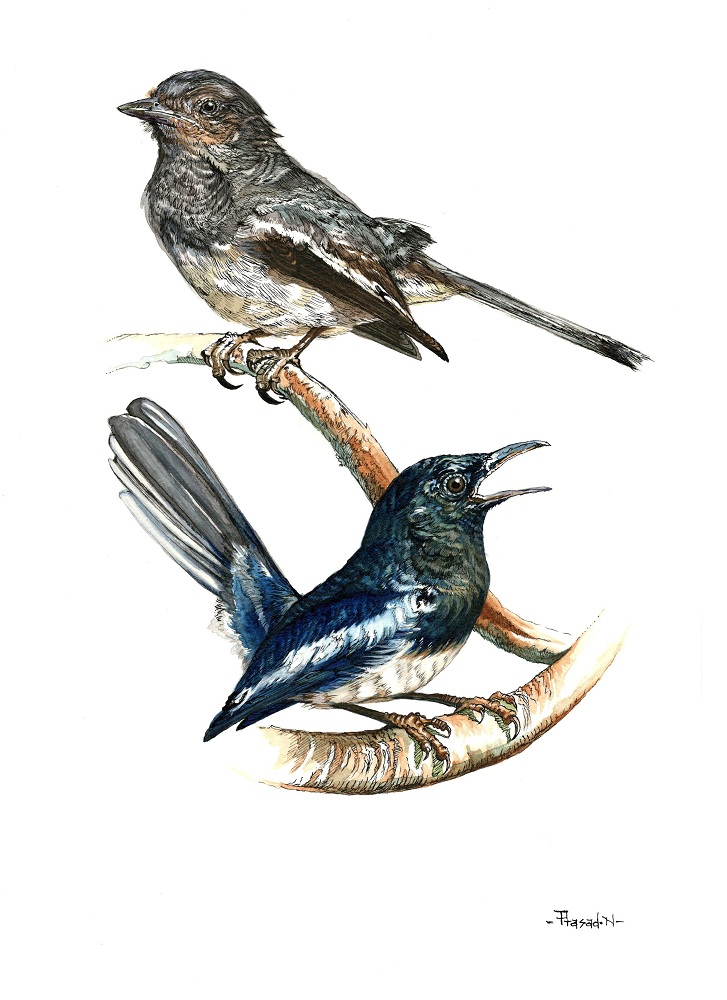

- Title: Singing Glory!
- Medium: Ink and water color on paper
- Duration: 12 hours
- January 15th, 2016
Welcome back everyone to another edition of birds of Bangalore. Hope you are having a great winter birdwatching. I just returned from an eventful birdwatching tour to Tal Chappar. Few lifers for me during this tour and it was led by Vipul Ramanuj, who made sure I concentrate only on watching out for birds in the field and rest is all well taken care off. His field knowledge is commendable and great hospitality, topping that, his understanding of light and angles for making good images. An average photographer like me was able to make sharp images with a normal camera gear in town. Credit surely goes to our tour guide, more to come about this in recitals.
Holidays are great time to sit back at common spots inside Bangalore and watch our resident feathery friends. Cubbon Park for me has been great place to watch our guest of this week; their songs enthrall my soul and fill my heart with peace. Many a times I have found solace in these songs, though there are no words nor do I comprehend their meaning. I have cherished many winter mornings under gulmohar trees and these sweets songs.
They are Bulbul sized birds, their bill is primary black both upper and lower mandible, crown, nape, mantle, back, rump, breast, top streak of the tail are all bluish glowing black, belly and both tail ends are white, eye is dark brown with black iris. There is a white streak running through the middle of their wings. Tarsus and toes colored grey. Females are much duller in color, greyish and white, young ones look light greyish in color, with similar white streak running through the middle of their wings, touch of light brown also run on their wing tips.
Any guesses? Not a Koel for sure; Oriental Magpie Robin (Copsychus saularis) it is! They are found in many urban gardens, mainly feeding on insects and sometimes feeding on nectar as well. House geckos have also been on their menu, have seen them prey on these geckos at horticulture center at Lalbagh as well. Since their diet mainly consist of insects these parks and gardens are haven for these small birds, which is also a reason for us to create more parks like these.
They breed from March to July, which is when the males are seen singing high pitch notes from top branches. They are also seen puffing their feathers, raising their bill and opening up their tails like a fan. Nests are built in little tree cavities with dry grass for cushion, unlike the Baya weaver, here the females take the lead in building the nests and also taken care of younger ones. Males fiercely protect their territory and most of their time is spent feeding and defending. They mate with all females in their territory; hence guarding his domain is his utmost priority.
They face tough competition from Common mynas and birds of prey hunt them down, and White throated kingfishers have also preferred them. They have been part of the pet trade for a long time, due to their singing ability. In some rural areas, these birds have been part of fight clubs, just like the rooster fight clubs.
Like all the singing birds, with increase in sound pollution, these birds are finding it difficult to call out their mates. Also seen many cultural activities in around the parks, however if we limit the usage of huge loud speaker it would be great favor to our singing birds, especially during their breeding season. I have enjoyed many mornings, listening silently to many bird calls and enjoyed going to our parks. However this noise from many events sometimes destroys my peace. Hope people go to our parks for re-creation without disturbing nature around them. We have many halls and bhavan’s for these events already, not sure if it’s a good idea to crack up tiny birds with loud speakers at our parks!
So until next week, Happy Birding!